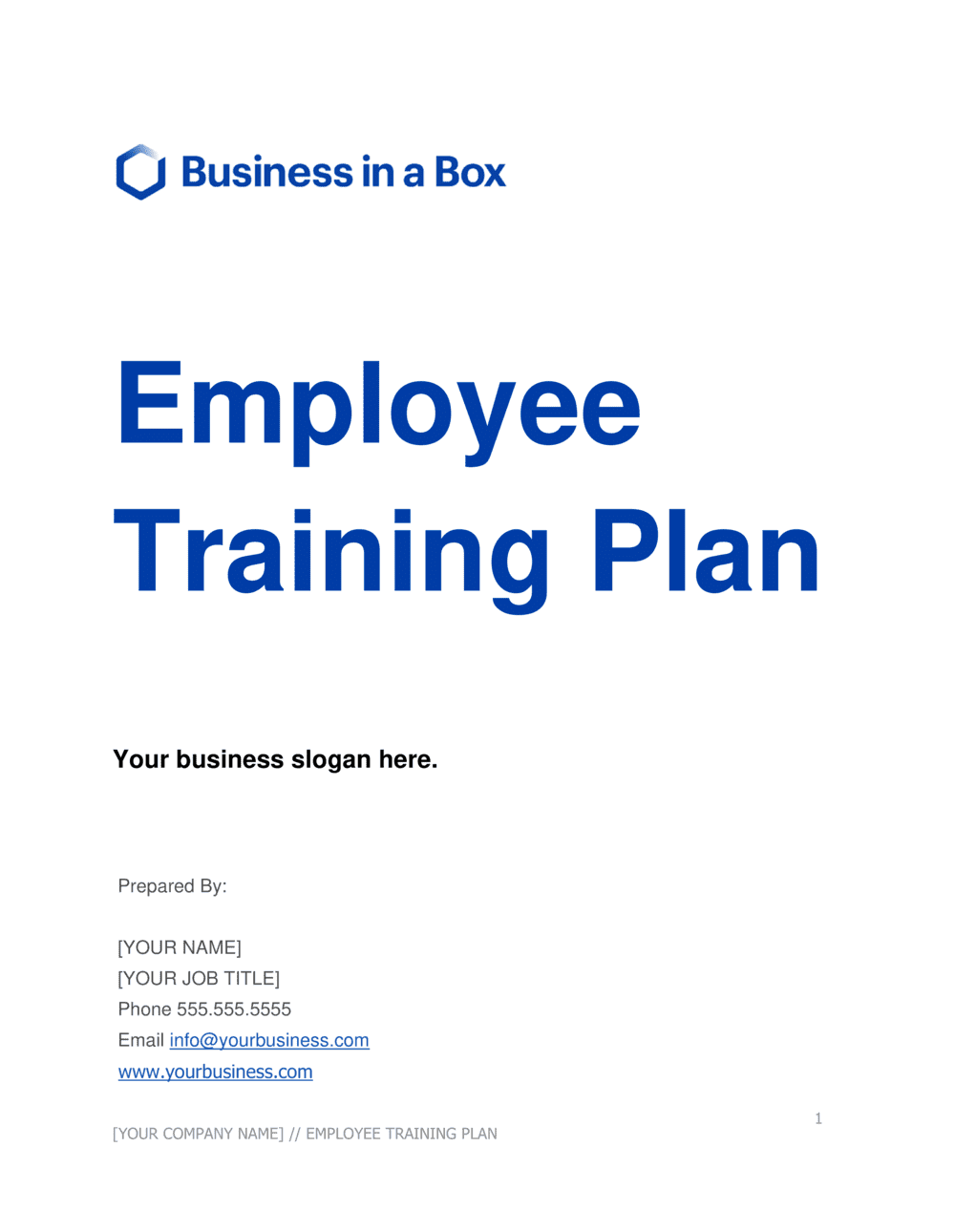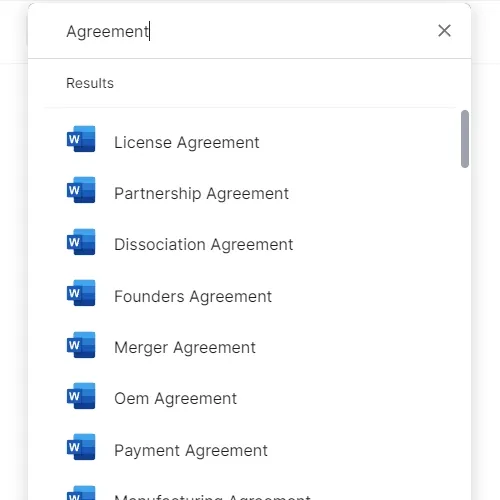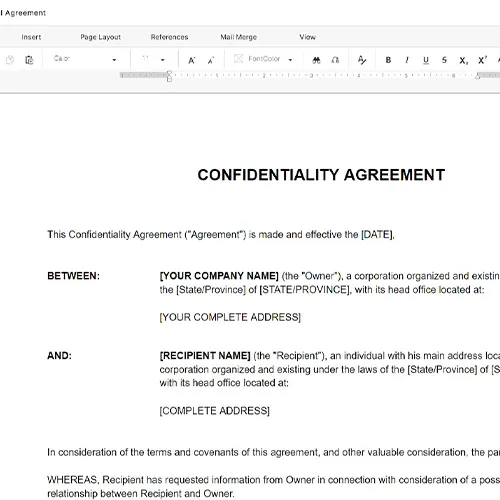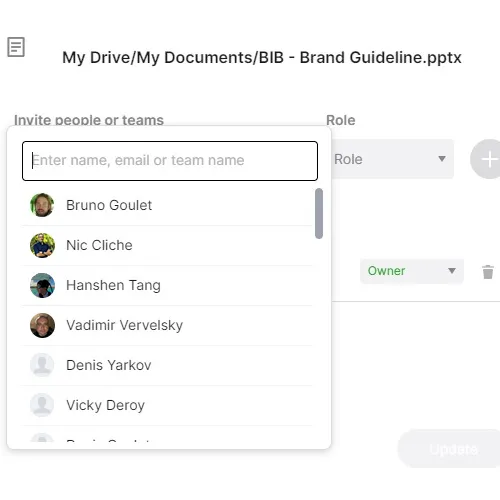Employee Training Plan Template

Sample of Document Content
This employee training plan template has 17 pages and is a MS Word file type listed under our human resources documents.
Employee training plan template
Employee Training Plan Your business slogan here. Prepared By: [YOUR NAME] [YOUR JOB TITLE] Phone 555.555.5555 Email info@yourbusiness.com www.yourbusiness.com Table of Contents Table of Contents 2 1. Executive Summary 3 1.1 Problem Definition 3 1.2 The Opportunity 3 1.3 The Solution 3 1.4 Goals and Objectives 3 1.5 Points of Contact 4 2. Instructional Analysis 5 2.1 Skill Analysis 5 2.2 Development Approach 6 2.3 Recommendations 6 3. Instructional Methods 7 3.1 Training Methodology 7 3.2 Training Database 7 3.3 Testing and Evaluation 8 4. Training Resources 10 4.1 Training Course Administration 10 4.2 Resources and Facilities 11 4.3 Schedules 12 4.4 Future Training 12 5. Training Materials List 13 5.1 Purpose and Scope 13 5.2 Training Materials List 14 6. Training Curriculum 15 7. Action Plan 16 8. Training Plan Approval 17 9. References 18 1. Executive Summary The executive summary will provide readers a brief yet dynamic description of the key components of the employee training plan. To make sure it is clear and comprehensive, it is often the last section to be written. A first-time reader should be able to read the summary by itself and know what your employee training plan is all about. The summary should stand alone and should not refer to other parts of your employee training plan. The summary, between one to three pages in length, will motivate readers to continue reading the remainder of the employee training plan in more detail. 1.1 Problem Definition Define the current problem relating to employee training. 1.2 The Opportunity Describe the opportunity for improvement. 1.3 The Solution Describe the solution. Note: you will need to go into detail about how you will execute the proposed solution in Section 2 and onward. 1.4 Goals and Objectives Based on the above, explain the goals and objectives that you want to achieve. They must be measurable, with a timeframe. 1.5 Points of Contact Provide the company name and the titles of key points of contact for overall system development. Examples of the points of contact are: Program Manager, Project Manager, Security Manager, QA Manager, Training Representatives, and Training Manager. Include all necessary additional lines as required in the table below. Role Name Contact Number Business Sponsor Program Manager Project Manager QA Manager Configuration Manager Center ISSO Training Manager/Coordinator Training Representatives 2. Instructional Analysis 2.1 Skill Analysis Describe the target audiences for the training courses that are intended to be developed. Examples of target audiences may include user professionals, clerical staff members, data entry clerks, ADP and non-ADP managers, technical professionals, and executives. Give a detailed description of the task that requires teaching to meet objectives and the skills required to learn tasks. Include the details of the training needs for each target audience in this section. If appropriate, ensure this section also discusses the needs and courses based on staff location groupings. S/N Course Target Audience 1. [Insert Course Name] [Ex: Data Entry Clerks] 2. 3. S/N Task Description Objectives Skills Required to Learn 1. [Insert Task Description] [Describe Task Objectives] [Explain Required Skills] 2. 3. 2.2 Development Approach Discuss the approach utilized for the development of the course curriculum and for ensuring development of quality training products. Include the methodology for the analysis of training requirements based on performance objectives. List and identify the topics or subjects for conducting training. SUBJECTS/TOPICS FOR TRAINING [Insert Subject] [Insert Subject] [Insert Subject] [Insert Subject] 2.3 Recommendations Provide current and possible problems relating to training. Include the recommendations for solving each issue. Fill in the table below Training Issue Recommendation 3. Instructional Methods 3.1 Training Methodology Provide an outline of the training method for the proposed courses. Fill in the table below for tracking. Training Methodology: S/N Course Target Audience Training Methodology 1. [Insert Course Title] [Choose Target Audience] [Describe Training Method] 2. 3. 4. 3.2 Training Database Identify and discuss the training database and its usefulness during the training process. This section should relate production data to various training scenarios and cases for instructional reasons. Go into more comprehensive detail on the method of training database development. Fill in (N/A) if this section isn't applicable to the company. 3.3 Testing and Evaluation Describe the methods utilized in the establishment and maintenance of quality assurance for the curriculum development procedure. Include methods for testing and evaluating effectiveness of training, employee progress and performance. Incorporate feedback for modification and enhancement of course structure and/or materials. Benchmark Method of Testing Feedback/Comment Prospective Employee Performance Employee Progress Training Effectiveness N
Reviewed on

Sample of Document Content
This employee training plan template has 17 pages and is a MS Word file type listed under our human resources documents.
Sample of our employee training plan template:
Employee Training Plan Your business slogan here. Prepared By: [YOUR NAME] [YOUR JOB TITLE] Phone 555.555.5555 Email info@yourbusiness.com www.yourbusiness.com Table of Contents Table of Contents 2 1. Executive Summary 3 1.1 Problem Definition 3 1.2 The Opportunity 3 1.3 The Solution 3 1.4 Goals and Objectives 3 1.5 Points of Contact 4 2. Instructional Analysis 5 2.1 Skill Analysis 5 2.2 Development Approach 6 2.3 Recommendations 6 3. Instructional Methods 7 3.1 Training Methodology 7 3.2 Training Database 7 3.3 Testing and Evaluation 8 4. Training Resources 10 4.1 Training Course Administration 10 4.2 Resources and Facilities 11 4.3 Schedules 12 4.4 Future Training 12 5. Training Materials List 13 5.1 Purpose and Scope 13 5.2 Training Materials List 14 6. Training Curriculum 15 7. Action Plan 16 8. Training Plan Approval 17 9. References 18 1. Executive Summary The executive summary will provide readers a brief yet dynamic description of the key components of the employee training plan. To make sure it is clear and comprehensive, it is often the last section to be written. A first-time reader should be able to read the summary by itself and know what your employee training plan is all about. The summary should stand alone and should not refer to other parts of your employee training plan. The summary, between one to three pages in length, will motivate readers to continue reading the remainder of the employee training plan in more detail. 1.1 Problem Definition Define the current problem relating to employee training. 1.2 The Opportunity Describe the opportunity for improvement. 1.3 The Solution Describe the solution. Note: you will need to go into detail about how you will execute the proposed solution in Section 2 and onward. 1.4 Goals and Objectives Based on the above, explain the goals and objectives that you want to achieve. They must be measurable, with a timeframe. 1.5 Points of Contact Provide the company name and the titles of key points of contact for overall system development. Examples of the points of contact are: Program Manager, Project Manager, Security Manager, QA Manager, Training Representatives, and Training Manager. Include all necessary additional lines as required in the table below. Role Name Contact Number Business Sponsor Program Manager Project Manager QA Manager Configuration Manager Center ISSO Training Manager/Coordinator Training Representatives 2. Instructional Analysis 2.1 Skill Analysis Describe the target audiences for the training courses that are intended to be developed. Examples of target audiences may include user professionals, clerical staff members, data entry clerks, ADP and non-ADP managers, technical professionals, and executives. Give a detailed description of the task that requires teaching to meet objectives and the skills required to learn tasks. Include the details of the training needs for each target audience in this section. If appropriate, ensure this section also discusses the needs and courses based on staff location groupings. S/N Course Target Audience 1. [Insert Course Name] [Ex: Data Entry Clerks] 2. 3. S/N Task Description Objectives Skills Required to Learn 1. [Insert Task Description] [Describe Task Objectives] [Explain Required Skills] 2. 3. 2.2 Development Approach Discuss the approach utilized for the development of the course curriculum and for ensuring development of quality training products. Include the methodology for the analysis of training requirements based on performance objectives. List and identify the topics or subjects for conducting training. SUBJECTS/TOPICS FOR TRAINING [Insert Subject] [Insert Subject] [Insert Subject] [Insert Subject] 2.3 Recommendations Provide current and possible problems relating to training. Include the recommendations for solving each issue. Fill in the table below Training Issue Recommendation 3. Instructional Methods 3.1 Training Methodology Provide an outline of the training method for the proposed courses. Fill in the table below for tracking. Training Methodology: S/N Course Target Audience Training Methodology 1. [Insert Course Title] [Choose Target Audience] [Describe Training Method] 2. 3. 4. 3.2 Training Database Identify and discuss the training database and its usefulness during the training process. This section should relate production data to various training scenarios and cases for instructional reasons. Go into more comprehensive detail on the method of training database development. Fill in (N/A) if this section isn't applicable to the company. 3.3 Testing and Evaluation Describe the methods utilized in the establishment and maintenance of quality assurance for the curriculum development procedure. Include methods for testing and evaluating effectiveness of training, employee progress and performance. Incorporate feedback for modification and enhancement of course structure and/or materials. Benchmark Method of Testing Feedback/Comment Prospective Employee Performance Employee Progress Training Effectiveness N
Easily Create Any Business Document You Need in Minutes.

Download or open template
Access over 3,000+ business and legal templates for any business task, project or initiative.

Edit and fill in the blanks
Customize your ready-made business document template and save it in the cloud.

Save, Share, Export, or Sign
Share your files and folders with your team. Create a space of seamless collaboration.


